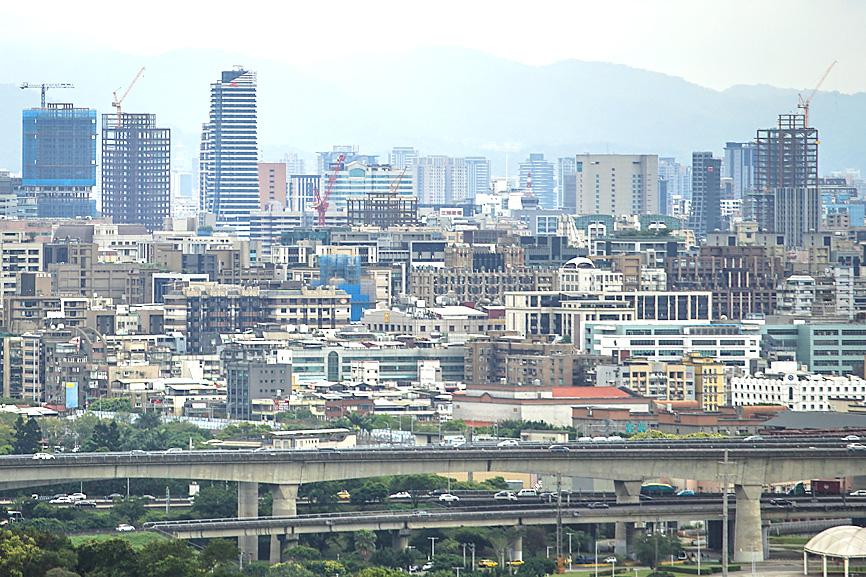The presale and new housing market in northern Taiwan shrank 14 percent in the second quarter from three months earlier to NT$228.55 billion (US$8.19 billion), as a local COVID-19 outbreak and unfavorable government policies weakened sentiment and pushed developers to the sidelines, the Chinese-language My Housing Monthly reported yesterday.
The trend suggested a steeper decline of up to 30 percent compared with the same period last year, the report said.
“Developers turned cautious and preferred to wait and see while the market assimilates to credit controls, property tax hikes and the lingering level 3 [COVID-19] alert,” My Housing Monthly research manager Ho Shih-chang (何世昌) wrote in the report.

Photo: CNA
The market could regain momentum next quarter thanks to the fall in local infections this month, Ho said.
Presale projects and newly completed houses might reach NT$550 billion and NT$600 billion respectively in the second half of this year, pushing the trading volume for the full year to surpass NT$1 trillion, Ho said, adding that he expects a number between NT$1.05 trillion and NT$1.1 trillion.
Developers are likely to introduce new projects next month or in September when Taiwan is expected to emerge from the virus outbreak, he said, adding that a solid economy and low interest rates would continue to lend support.
In the first half of the year, presale and newly finished houses in northern Taiwan totaled NT$494.64 billion, representing a 19 percent retreat from a year earlier, the report said.
Taipei posted the biggest decline nationwide, with sales dropping 37 percent to NT$109.7 billion in the first six months, Ho said, attributing the decline to the severity of the COVID-19 outbreak in the capital and the relatively strong effect of the policy measures on the city’s housing market.
However, prices held relatively firm in Taipei, thanks to tight supply, he said.
New Taipei City reported a 17.6 percent decline to NT$195 billion, while sales in Taoyuan fell 20 percent to NT$107.3 billion, the report said.
Hsinchu City bucked the trend as it posted an annual increase of 25 percent to NT$68.8 billion, it said.
Keelung and Yilan County also reported increases of 25.8 percent and 17 percent respectively, the report said.
Separately, Taichung-based Sakura Development Co (櫻花建設) on Tuesday said that it is expecting improved earnings in the second half of this year, as profits from five residential projects in Taichung would be booked.
The company finished the first six months with net losses per share of NT$0.07 due to an 88 percent annual retreat in revenue to NT$166 million.
However, the company is to wrap up construction at five residential complexes with 916 apartment units in Taichung that are expected to generate NT$8.4 billion in sales, it said.
The five projects are all sold-out, and the company would book the profits upon turning over the keys to buyers.
Sakura Development said it would refocus its strategy away from the presale market, as transfers of presale contracts within five years of purchase would be subject to property taxes of 35 to 45 percent.
It would instead focus on new projects that it would market once fully or partly completed, it said.

Nvidia Corp chief executive officer Jensen Huang (黃仁勳) on Monday introduced the company’s latest supercomputer platform, featuring six new chips made by Taiwan Semiconductor Manufacturing Co (TSMC, 台積電), saying that it is now “in full production.” “If Vera Rubin is going to be in time for this year, it must be in production by now, and so, today I can tell you that Vera Rubin is in full production,” Huang said during his keynote speech at CES in Las Vegas. The rollout of six concurrent chips for Vera Rubin — the company’s next-generation artificial intelligence (AI) computing platform — marks a strategic

Enhanced tax credits that have helped reduce the cost of health insurance for the vast majority of US Affordable Care Act enrollees expired on Jan.1, cementing higher health costs for millions of Americans at the start of the new year. Democrats forced a 43-day US government shutdown over the issue. Moderate Republicans called for a solution to save their political aspirations this year. US President Donald Trump floated a way out, only to back off after conservative backlash. In the end, no one’s efforts were enough to save the subsidies before their expiration date. A US House of Representatives vote

REVENUE PERFORMANCE: Cloud and network products, and electronic components saw strong increases, while smart consumer electronics and computing products fell Hon Hai Precision Industry Co (鴻海精密) yesterday posted 26.51 percent quarterly growth in revenue for last quarter to NT$2.6 trillion (US$82.44 billion), the strongest on record for the period and above expectations, but the company forecast a slight revenue dip this quarter due to seasonal factors. On an annual basis, revenue last quarter grew 22.07 percent, the company said. Analysts on average estimated about NT$2.4 trillion increase. Hon Hai, which assembles servers for Nvidia Corp and iPhones for Apple Inc, is expanding its capacity in the US, adding artificial intelligence (AI) server production in Wisconsin and Texas, where it operates established campuses. This

US President Donald Trump on Friday blocked US photonics firm HieFo Corp’s US$3 million acquisition of assets in New Jersey-based aerospace and defense specialist Emcore Corp, citing national security and China-related concerns. In an order released by the White House, Trump said HieFo was “controlled by a citizen of the People’s Republic of China” and that its 2024 acquisition of Emcore’s businesses led the US president to believe that it might “take action that threatens to impair the national security of the United States.” The order did not name the person or detail Trump’s concerns. “The Transaction is hereby prohibited,”